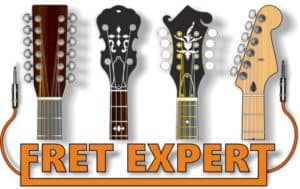For a beginner, the thought of having to tune an instrument like the ronroco is a little daunting, but fear not, it’s a lot simpler than you would imagine.
Tuning a ronroco is a lot easier if you think about it as a 5-string instrument. It has ten strings, but these are arranged in five separate pairings, with four of the five sets tuned to the same individual notes – i.e. two ‘G’ strings, two ‘C’ strings, etc.
The only variation comes with the middle set of strings which are tuned an octave apart – namely a high ‘E’ and a low ‘E’ in Bolivian tuning, for example.
Pairs of strings or double strings are often referred to as having two courses of strings. A course is just an alternative way of describing the string configuration of a stringed instrument. So in the case of the ronroco, you would describe it as having five double courses of strings.
Covered in this Article:
What is Standard Tuning for a Ronroco?
The ronroco is tuned according to regional preference. Three basic tunings are popular throughout the Andean region and are all based around a major sixth chord, albeit in different keys:
Bolivian Ronroco Tuning
Bolivian Tuning (GCEAE) is pitched an octave below standard charango tuning. It’s also tuned to an open C6 chord, like the ukulele:
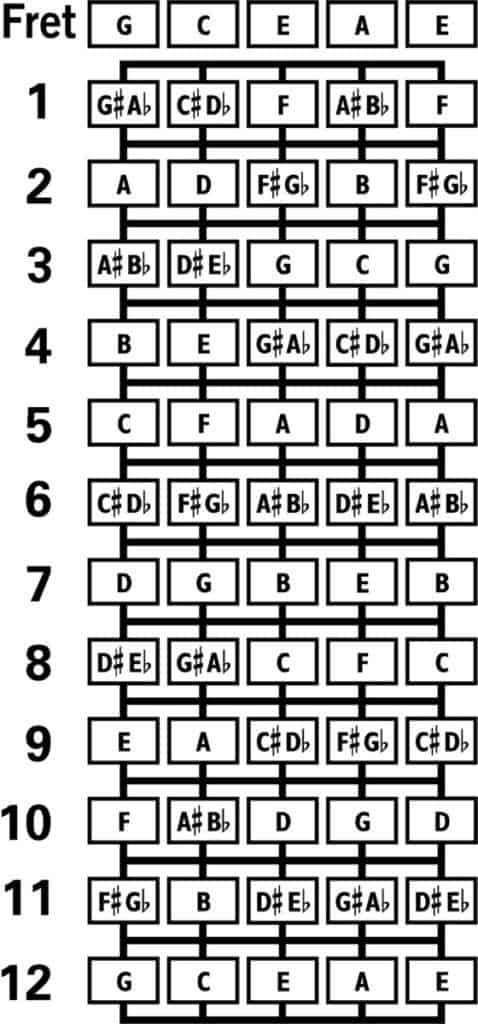
Fourths Ronroco Tuning
Fourths Tuning is, as you might imagine, a fourth below standard charango tuning. The ronroco is tuned to DGBEB or an open G6 chord, like the baritone ukulele:
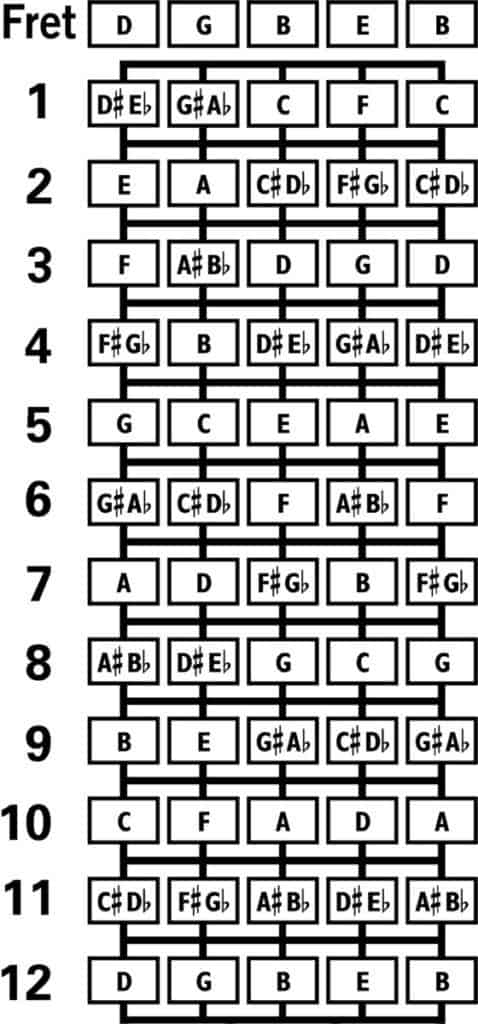
Fifths Ronroco Tuning
Fifths Tuning is another popular configuration; a whole tone lower than fourths. The tuning is CFADA, or an open F6 chord:
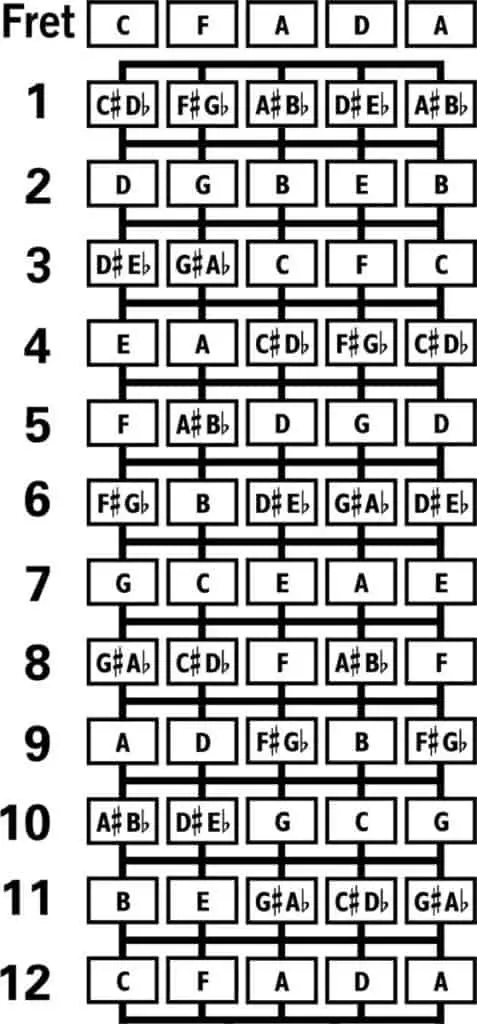
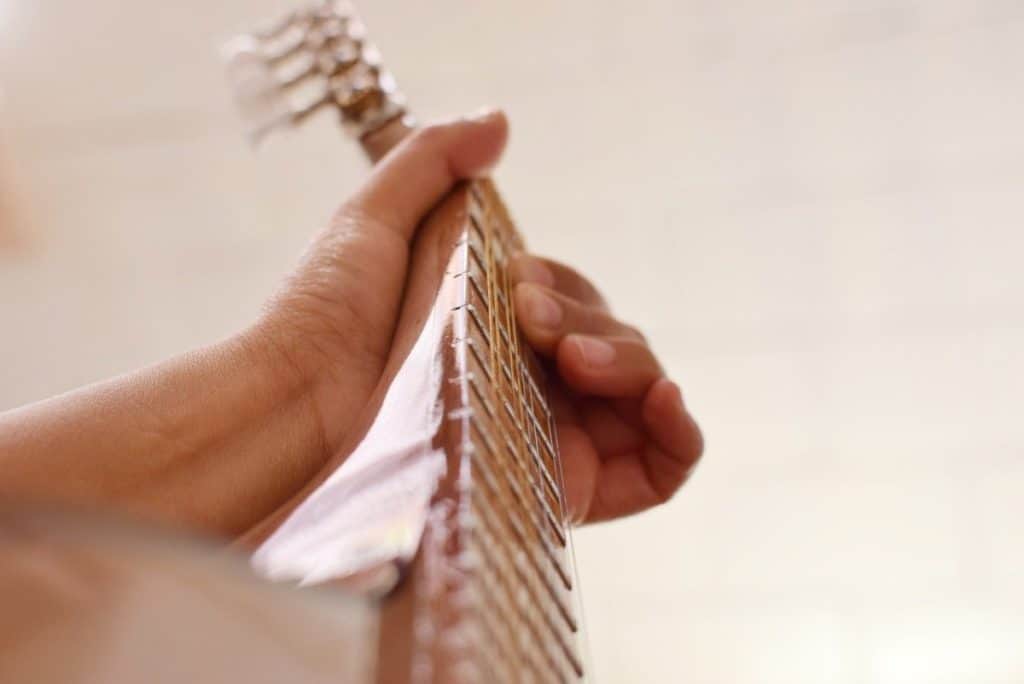
How To Tune a Ronroco
A number of ronroco tuning methods are available if you have access to an electronic tuner, piano or guitar. To read more on this, check out my article on all the ways you can tune an instrument. Three are below:
Electronic Tuners
This is the most accurate method. This will tell you exactly if the note is sharp or flat and takes the guesswork out of the tuning process. You can check out my recommended electronic tuners here.
Tuning a Ronroco to a Keyboard or Digital Piano
If you have an electronic keyboard or digital piano, this is also an accurate method of tuning your ronroco. The easiest way to do this is to press the piano key of the note you’re trying to tune, whilst depressing the sustain or damper pedal on your pedalboard, if you have one.
This way, the note will sustain for a while as you tune the string to the correct pitch. Unfortunately, this is open to human error if you have trouble distinguishing between a note being sharp, on pitch or flat. As most people have a reasonable ear with regard to pitch, a pretty accurate result should be achievable. See below for some tuning tables.
Tuning a Ronroco to a Guitar
You can always tune your ronroco to a guitar, particularly if it already has a built-in tuner, as many electro-acoustic guitars do.
Ronroco to Piano or Guitar Tuning Tables:
These tables can be used to tune a ronroco to piano and guitar, and will also work for 4ths/5ths tuning on a charangon, too.
Table 1: Bolivian Ronroco Tuning to Guitar or Piano
| Ronroco (Bolivian Tuning) | Guitar | Piano |
|---|---|---|
| 1st & 2nd string (E) | 1st open string (E) | 1st E above middle C |
| 3rd & 4th string (A) | 3rd string (G) fretted at the 2nd fret | 1st A below middle C |
| 5th low octave string (E) | 4th string fretted at the 2nd fret (D) | 1st E below middle C |
| 6th string (E) | 1st open string (E) | 1st E above middle C |
| 7th & 8th string (C) | 2nd string (B) fretted at the 1st fret | Middle C |
| 9th & 10th string (G) | 3rd open string (G) | 1st G below middle C |
Table 2: Ronroco or Charangon 4ths Tuning to Guitar or Piano:
| Ronroco or Charangon 4ths Tuning | Guitar | Piano |
|---|---|---|
| 1st & 2nd string (B) | 1st string (E) fretted at the 7th fret | 1st B above middle C |
| 3rd & 4th string (E) | 2nd string (B) fretted at the 3rd fret | 1st E above middle C |
| 5th low octave string (B) | 2nd open string (B) | 1st B below middle C |
| 6th string (B) | 1st string (E) fretted at the 7th fret | 1st B above middle C |
| 7th & 8th string (G) | 1st string (E) fretted at the 3rd fret | 1st G above middle C |
| 9th & 10th string (D) | 2nd string (B) fretted at the 3rd fret | 1st D above middle C |
Table 3: Ronroco or Charangon 5ths Tuning to Guitar or Piano:
| Ronroco or Charangon 5ths Tuning | Guitar | Piano |
|---|---|---|
| 1st & 2nd string (A) | 1st string (E) fretted at the 5th fret | 1st A above middle C |
| 3rd & 4th string (D) | 2nd string (B) fretted at the 3rd fret | 1st D above middle C |
| 5th low octave string (A) | 3rd string fretted at the 2nd fret | 1st A below middle C |
| 6th string (A) | 1st string (E) fretted at the 5th fret | 1st A above middle C |
| 7th & 8th string (F) | 1st string (E) fretted at the 1st fret | 1st F above middle C |
| 9th & 10th string (C) | 2nd string (B) fretted at the 1st fret | Middle C |
Pro Tip: Tuning a Ronroco To Itself
Another method is to tune the ronroco to itself. This may sound a little bizarre, but in practice, the only note you need to achieve this is the lowest note on your instrument (not including the low octave middle string).
In the case of the ronroco, this is the ‘G’ from Bolivian Tuning, the ‘D’ from Fourths Tuning or the ‘C’ from Fifths Tuning. Once you have that initial string tuned up accurately, you can find the other notes by fretting on specific frets on the fingerboard, working from low to high.
This is illustrated below:
Self-Tuning Ronroco (Bolivian) C6
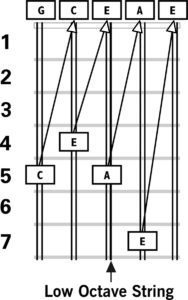
Self-Tuning Ronroco 4ths (G6)
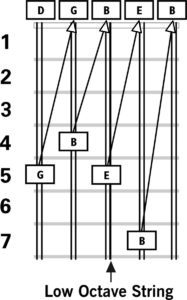
Self-Tuning Ronroco 5ths (F6)
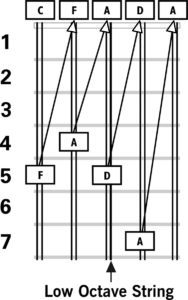
The final string you need to tune is the low octave middle fifth string. Fret the string on the 12th fret until it matches its partner, the 6th string. Always tune this string last:
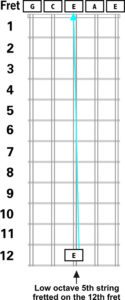
The same method applies to all three tunings in relation to which frets you need to select from your fingerboard. The relationships are the same, but in different keys.
Usefully, the same rule applies to other members of this family grouping including the charango, charangon and the walaycho.
Ronroco Notation Tuning
If you’re wondering what the notation is for tuning a ronroco in each style, this is illustrated below:
Ronroco Bolivian Tuning Notation:

Ronroco 4ths Tuning Notation:

Ronroco 5ths Tuning Notation:

Why Does My Ronroco Go Out Of Tune?
One of the perils of having to replace a string or a whole set of strings on any stringed instrument is the inevitable bedding-in period.
If your ronroco keeps going out of tune, you’ll probably want to read this article I wrote about keeping fretted instruments from going out of tune.
If you want to find out which ronroco strings are best for different tunings, then click here to see my recommendations.
What is Scientific Pitch Notation with regard to the Ronroco?
Every note in the full musical scale has a designated name attached to it. To give you an example, the ‘C’ note in the middle of virtually every piano in existence is described as a ‘C4’.
This tells you the note and which octave it should played in. Confusingly, Two systems are extensively used, but which you choose doesn’t really matter.
The first was created by The Acoustical Society of America. It uses the numbering system which I’ve briefly described above. The second is Helmholtz, a labelling system using a combination of upper and lower case note names, combined with apostrophes.
Again, using middle ‘C’ as an example, in Helmholtz, it would be written as c’ (lower case c with an apostrophe). Helmholtz is named after a German scientist, Hermann von Helmholtz, who originally devised the system.
Another useful piece of information to know about music is that every octave has a specific name. These loosely tie in with the ledger lines on a musical stave or staff. Here’s a list of the octaves from a standard 88-note piano ranging from lowest to highest, using the key of C as an example, along with the corresponding ASA and Helmholtz octave designation abbreviations:
- Sub-Contra Octave (C0 or CCC)
- Contra Octave (C1 or CC)
- Great Octave (C2 or C)
- Small Octave (C3 or c)
- One-Line Octave (the middle ‘C’ octave) (C4 or c’)
- Two-Line Octave (C5 or c’’)
- Three-Line Octave (C6 or c’’’)
- Four-Line Octave (C7 or c’’’’)
- Five-Line Octave (C8 or c’’’’’)
The octave designations on a standard 88-note piano keyboard are shown below:

